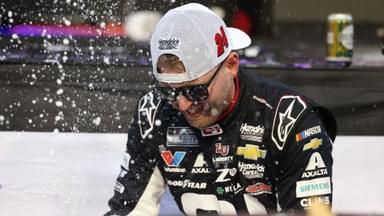Sometimes you gamble and win, other times you lose. That was the case for William Byron in this past Sunday’s NASCAR Cup race at Michigan International Speedway.
Advertisement
Byron was challenging Denny Hamlin for the lead and was hoping and praying that he had enough fuel to make it to the finish line. Unfortunately, Byron ran out of gas and had to pit with one lap left, ending his chance of winning a second race of the season, and instead relegating him to a disappointing 28th-place finish.
Byron’s running dry was among the topics covered in Monday’s NASCAR Inside The Race Live with co-hosts Steve Letarte, Jeff Burton, and Todd Gordon.
Byron started the season in the best way possible by winning the Daytona 500 for the second straight year. But Byron has let several other potential wins slip through his fingers — but not necessarily of his own doing.
Three races have slipped through Byron’s fingers
Byron dominated Darlington but lost due to bad late-race pit strategy, finishing second. He dominated the Coca-Cola 600 at Charlotte, but once again came up short, finishing second to Ross Chastain.
And then there was Sunday in Michigan’s Irish Hills. Byron coulda, woulda, shoulda won the race, but his failure to save enough fuel for one more go-round of the two-mile oval was his undoing. He lost — and lost big.
So instead of potentially having as many as four wins to date, Byron only has one. “The fact is (Byron had) two dominant performances, no trophies,” Letarte said. “This one (Michigan), not as dominant but in the mix, in the conversation, in position, once again fell short.”
A crew chief’s gotta do what he’s gotta do
But Letarte also gave kudos to Byron’s crew chief, Rudy Fugle. Some crew chiefs would have told Byron to conserve, conserve and conserve more fuel to make sure he got to the end, but Fugle had a different strategy.
“I loved the radio. Rudy Fugle was ‘Hey man, go as fast as you can and save as much as you can and don’t lose the lead,’” Letarte said. “And those are nearly impossible to do. I didn’t think it was going to be possible, but I love that they were willing to run out of gas.
“I think Rudy could have coached him to a seventh-place finish with enough gas. But the win at the Daytona 500 and this point system says that doesn’t matter as much as rolling the dice, and here’s why. Let me explain to the fans, I don’t think he knew he was going to save three extra (laps).
“He knew he was going to be a lap or two short, but if you get a yellow as the leader and you shut that car off and you coast two or three laps, now you’re making it and you still have control of the race. That was the strategy call for the 24. He just came dry and had to pit coming in (with) one to go.”
Gordon then indicated that a typical five-lap caution usually buys a driver three laps worth of fuel. “If William Byron’s running third, Rudy calls this race differently. But when you’ve got the win in front of you, you can’t give that up, you’ve got to take the gamble,” Gordon added.
As for the gambling, it’s as the late Kenny Rogers used to sing, “You got to know when to hold ’em, know when to fold ’em.”








